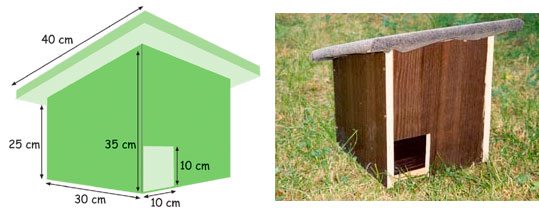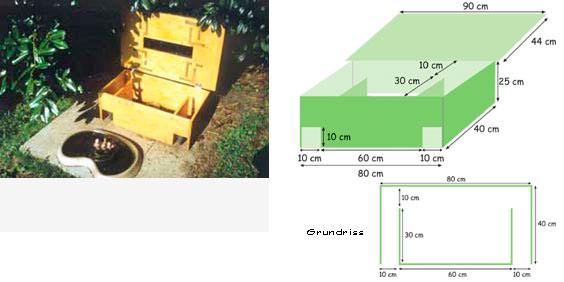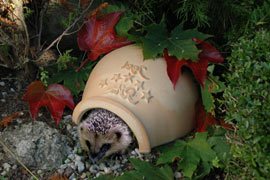Gardens have become very important habitat for hedgehogs. Natural garden design and management are the best prerequisites to ensure that hedgehogs will settle in. You can easily make shelters for hedgehogs. Nest boxes of different types can be provided as extra enticement for prickly visitors.
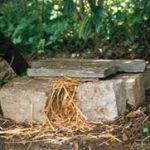
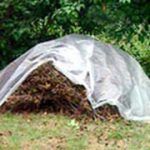
Hedgehogs build their nests under thorn bushes, under piles of leaves and brushwood or in the hollow spaces in tree roots.
There are many ways to create or obtain natural shelters for hedgehogs. In the autumn don’t tidy up the garden too much
It is easy to help the hedgehog build his nest, from leaving fallen leaves under bushes and hedges, in the space under the garden chalet etc to making piles of leaves or logs in sheltered spots in parks and gardens.
Simple hedgehog house
A wooden house for hedgehogs can be made from offcuts of tongue and groove slotted together or from pieces of wood or chipboard.
Materials:
– 1 piece of wood 40 x 40 cm for the roof
– 1 piece of wood 26 x 26 cm for the floor
– 2 pieces of wood 30 x25 or 30 cm for the sides (slanted)
– 1 piece of wood 26 x 35 cm for the front
– 1 batten 33 cm long
– 1 batten 23 cm long
– 2 battens 25 cm long
– For a removable roof: 2 battens 20 cm long, 2 cm thick
– 1 piece of roofing felt approx 50 x 50 cm
– Nails or screws, hammer, saw, measuring tape
– Non toxic, eco-friendly wood preserver
When you have cut the wood to size, cut an entrance hole 10cm wide and 12 cm high in the front, so that the opening is either on the right or the left. Nail or screw the sides to the floor and then join the walls together. Cover the roof with felt, wrapping it over the edges of the roof and nailing it under the overhang.
On the inside of the roof nail 2 battens centrally 7.5cm from the front or back edge. These battens are necessary to prevent the roof slipping off because of the slant. Paint the hedgehog house with eco-friendly wood preserver and let it air for a week or two before filling it with plenty of nest material. The best material to use is oat straw.
You can save and/or print the Instructions here (PDF)!
Hedgehog house with L-shaped entrances
This house is fairly cat-proof, it makes a good feeding house at times when natural food is scarce. It has two entrances because often several hedgehogs come to feed at the same time. The house should have no floor if it is intended as a feeding house. The best place to put it is on smooth concrete paving slabs (e.g. upside down exposed aggregate slabs) that can be rinsed clean with the garden hose.
Materials:
– 2 pieces of wood 80 x 25 cm for the long sides
– 2 pieces of wood 40 x 25 cm for the short sides
– 2 pieces of wood 30 x 25 cm for the entrance tunnels
– 2 pieces of wood 90 x 22 cm for the roof
– 2 battens 35 cm long and 2 cm thick for the roof
– 1 piece of roofing felt 95 x 48 cm
– 8 galvanised or brass angle irons
– 2 galvanised or brass hinges
– Saw, hammer, nails, screws, screwdriver, gimlet, measuring tape, pencil
– non-toxic eco-friendly wood preserver
Cut a 10 x10 cm square out of each end of one of the 80cm long pieces of wood. Then join the 80cm and the 40 cm long pieces with 2 angle irons at each corner to make a box without a roof or floor. Nail or screw the sides together at the corners as well.
Put the 30 cm long pieces inside the box (front to back) and screw them from the outside to the right and left respectively of both entrance holes in the front of the feeding house. It is best to make the screw holes first to be sure of screwing into the edge of the wood!
Make the roof by placing the two 90 cm pieces together and joining them with the battens. Next, wrap it with roofing felt and nail to the edge of the roof with flat-headed roofing nails.
Finally, screw both hinges to the back of the box and to one of the long sides of the roof (don’t leave any overhang to prevent rain getting in!) and paint the feeding box with eco-friendly weatherproofing preserver.

We have not included information on prices because these cannot be kept up to date; for the same reason, we have not given the retailers’ e-mail addresses. You can find other outlets through search engines on the internet.
“Sassener Hedgehog House” (see picture 1)
Material: Wood
Adress: Werkstätten der Lebensgemeinschaft e.V. Sassen und Richtdorf
Holzwerkstatt Sassen in D-36110 Schlitz-Sassen
Telephone and Fax 06642-802132
“Snail pro Hedgehog House” (see picture 2)
Material: Wood – – 2 varieties: Larch (more durable) and pine
Adress: Prime Factory GmbH & Co. KG, Abteilung Schneckenprofi
Seelust 4 in D-25581 Hennstedt
Telephone 01805 – 724 632 536, Fax 01805 – 724 632 632
“Schwegler Hedgehog Dome”
Material: Wood concrete composite
Adress: Schwegler Vogel- & Naturschutzprodukte
Heinkelstr. 35 in D-73614 Schorndorf
Telephone 07181-97745-0, Fax 07181-9774549
“SchmidtGarten’s Hedgehog House”
Material: Wickerwork
Adress: Axel Schmidt
Okerstrasse 10 – 10a in D-38100 Braunschweig
Telephone 0531-12167477, Fax 0531-2392770
“Igel-Ritz” & “Igel-Schnecke”
Material: terracotta
Adress: Denk Keramische Werkstätten
Neershof in D-96450 Coburg
Telefon 09563-2028, Fax 09563-2020
“Igelhäuser von Vivara”
Material: Wood
Adress: Vivara Naturschutzprodukte
Postfach 2520 in 41312 Netttal-Kaldenkirchen
Telefon 0180-3848272, Fax 0180-5848570
“Igel-Pension”
Material: Wood
Adress: Bürger für Berber e.V.
Eberspächerstrasse 31 in D-73730 Esslingen a.N.
Telefon 0711-359016, Fax 0711-6646510
All artificial nest boxes should be cleaned once a year after hibernation but before the breeding season and filled with new nesting material.
Hedgehog feeding houses must be regularly cleaned! It is advisable to place them on paving stones which can be well hosed down and/or brushed off. Put newspaper under the feeding dishes and change it every day. Wash the bowls daily in hot water. Hygiene is vital to avoid disease transmission at the feeding station.




